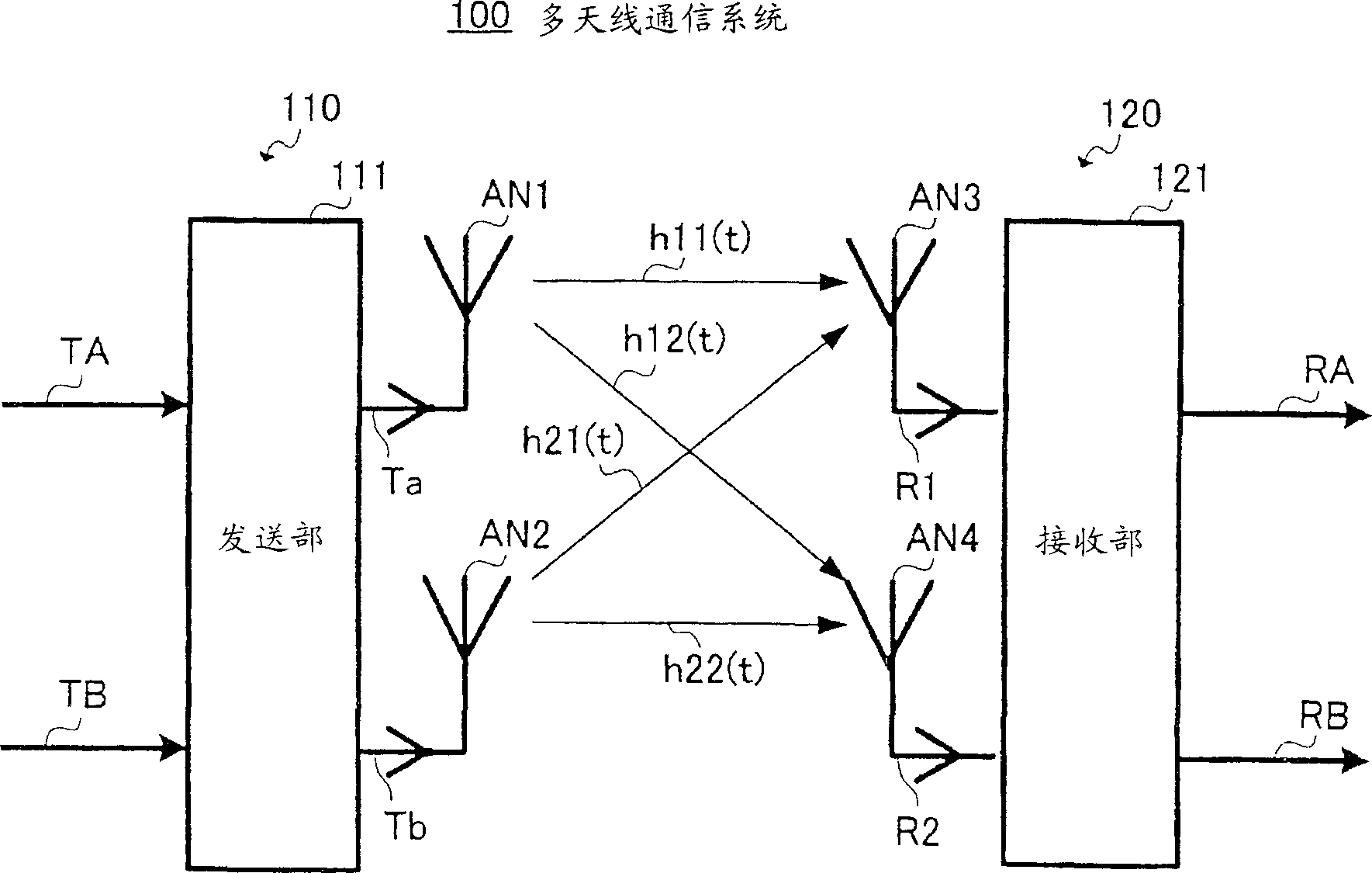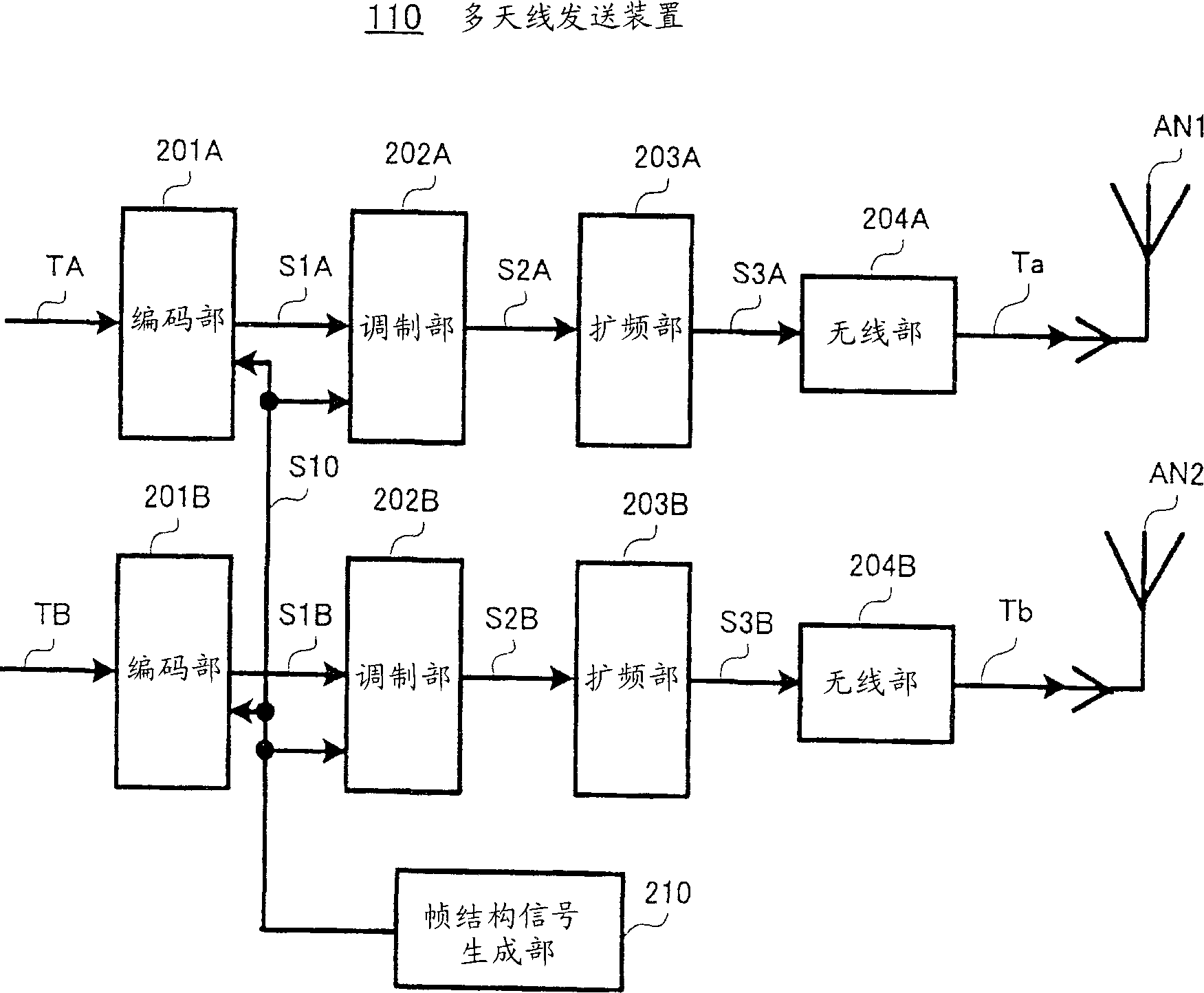Multi-antenna receiving apparatus, multi-antenna receiving method, multi-antenna transmitting apparatus, and multi-antenna communication system
A technology for receiving devices and sending devices, which is applied in diversity/multi-antenna systems, multi-frequency code systems, multiplex communication, etc., and can solve problems such as complex structures of receiving devices
- Summary
- Abstract
- Description
- Claims
- Application Information
AI Technical Summary
Problems solved by technology
Method used
Image
Examples
Embodiment approach 1
[0172] figure 1 The overall configuration of the multi-antenna communication system described in this embodiment is shown. In this embodiment, in order to simplify the description, the case where there are two transmitting antennas and two receiving antennas is described, but it is applicable to M (M≥2) transmitting antennas and N (N≥2) receiving antennas. Antennas for multi-antenna systems.
[0173] The multi-antenna transmission device 110 of the multi-antenna communication system 100 obtains the modulated signals Ta and Tb by performing predetermined modulation processing and conversion processing to radio frequency on the respective transmission digital signals TA and TB in the transmission unit 111, and transmits them from the antennas AN1 and AN2 to send. The multi-antenna reception device 120 inputs reception signals R1 and R2 received by the respective antennas AN3 and AN4 to the reception unit 121 . The receiving section 121 obtains received data RA and RB correspo...
Embodiment approach 2
[0217] In this embodiment, a configuration is proposed in which a portion for performing dummy determination for reducing candidate signal points is simpler than in Embodiment 1, so that received data with a better error rate characteristic can be obtained with a simpler configuration. Multi-antenna receiver.
[0218] exist Figure 12 in, right with Figure 5 Corresponding parts are denoted by the same reference numerals, and show the configuration of the signal processing unit 1200 of the multi-antenna reception device in this embodiment. exist Figure 12 The signal processing section 1200 with Figure 5 Compared with the signal processing unit 404 of the present invention, the soft decision unit 506 ( Figure 5 ). Then, the reception data RB of the modulated signal B obtained by the soft decision unit 518 is input to the signal point reduction units 1201 and 1202 . The signal point reduction units 1201 and 1202 use the received data RB obtained by the soft decision uni...
Embodiment approach 3
[0223] In this embodiment, in addition to reducing candidate signal points and performing main judgment to obtain received data with good error rate characteristics with a small number of calculations, it is also proposed to further improve error rate characteristics through the application of iteration technology. multi-antenna receiver.
[0224] exist Figure 13 , right with Figure 5 Corresponding parts are assigned the same reference numerals, and show the configuration of the signal processing unit 1300 of the multi-antenna reception device in this embodiment. That is, the signal processing section 1300 is used to replace Figure 4 The signal processing unit 404 is used in the multi-antenna receiving device 120 .
[0225] described in Embodiment 1 Figure 5 The difference between the signal processing unit 404 and the signal processing unit 1300 of this embodiment is that the signal point reduction units 1301 and 1302 receive input from the soft determination unit 518 i...
PUM
 Login to View More
Login to View More Abstract
Description
Claims
Application Information
 Login to View More
Login to View More - R&D
- Intellectual Property
- Life Sciences
- Materials
- Tech Scout
- Unparalleled Data Quality
- Higher Quality Content
- 60% Fewer Hallucinations
Browse by: Latest US Patents, China's latest patents, Technical Efficacy Thesaurus, Application Domain, Technology Topic, Popular Technical Reports.
© 2025 PatSnap. All rights reserved.Legal|Privacy policy|Modern Slavery Act Transparency Statement|Sitemap|About US| Contact US: help@patsnap.com



